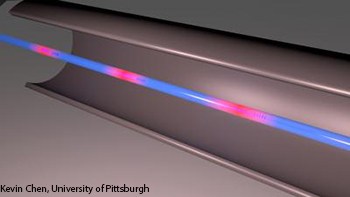
In the fiber optic flow sensor, the glowing red sections along the optical fiber are the sensors—hundreds of these sensors can be packed into a single fiber.
Gas flow rates are commonly calculated with a network of electrical sensors, such as MEMS, but these electronics fail at temperatures above 200°C. Researchers from the University of Pittsburgh, U.S.A., have developed an all-optical, low-cost, flexible method to measure gas flow in environments as high as 850°C (Opt. Lett. 39, 3966). This durability could find use in optical flow sensors suitable for harsh environments like geothermal drill cores, nuclear reactors and outer space.
Kevin Chen and his colleagues in the department of electrical and computer engineering demonstrated the all-fiber high-temperature flow sensor in a tube with N2 gas. Their fiber optic flow sensor is based on optical hot-wire anemometry (HWA). HWA flow sensors calculate flow rate by measuring the heat transfer between a heated element and a temperature sensor. The researchers used regenerative fiber Bragg gratings (RFBGs) as sensors in high-attenuation fibers (HAFs) and standard telecommunication fibers.
First, they heated the HAF via an in-fiber optical heating element. An RFBG in the HAF measured the temperature of the optical heating element, and the RFBG in the telecom fiber (upstream of the gas flow) measured the ambient temperature surrounding the heating element. An optical spectrum analyzer collected data from the RFBGs and calculated flow rate based on the heat transfer. The team reported reliable gas flow measurements between 0.066 m/s and 0.66 m/s from room temperature up to 850°C.
Optical fiber’s multiplexing capabilities and immunity to electromagnetic interference eliminate the space and wiring problems associated with electronic sensors. The team says that this technology could also be used in super-cold environments, as well as locations with strong magnetic interference.
